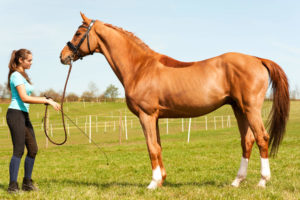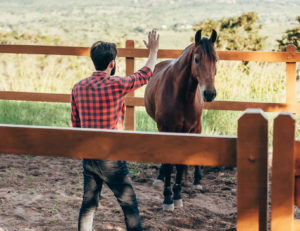
Updated on August 16, 2022.
Most riders sense that they have an unspoken bond with the horses they are close to, but do horses really have an innate capacity for reading human body language? Amy Smith, a researcher at the University of Sussex, wanted to learn more about horses’ ability to interpret non-verbal communication. Smith and her research team created an experiment to determine if horses could read the body language of people.
“Horses are often thought to be good at reading human body language,” Smith said. “However, little research has empirically tested the flexibility of cross-species communication.”
The Study

The Cognition Research Group recruited 30 domestic horses from three equestrian centers in Suffolk and East Sussex. To remain anonymous to the horses, female handlers of a similar size, and dressed in similar clothing, were the ones to feed the horses. They all wore a dark neck warmer to cover their faces from the bridge of the nose down to minimize facial expression cues. The handlers fed the horses in a neutral posture. Then, later, the horses were given a free choice to approach either the person displaying the dominant posture or the submissive demeanor.
The focus of their research was to determine whether these equines were more likely to approach one or the other. The dominant posture was characterized as a stance that takes up space. A straight-standing posture, chest expanded, and the arms and legs apart. In contrast, the submissive posture involved a slouch with knees bent and keeping their arms and legs tight to the body (see image).
Dr. Leanne Proops is the University of Portsmouth’s Senior Lecturer for the Psychology Department. She proposed that horses might have an instinctual understanding of larger versus smaller postures. “Evolutionarily speaking, animals — including humans — tend to use larger postures to indicate dominance or threat,” Proops said. “They use smaller postures to indicate submissiveness.”
Related Article: Helping Low Energy Horses
The Results of Horse Body Language
The researchers concluded that not only could horses tell the difference between our dominant and submissive body postures, but that horses were significantly more likely to approach a trainer in a submissive body posture than a dominant posture. Furthermore, these results show to be true in follow-up trials.
 These results can help the way we present ourselves in, as well as outside of, the barn. Clara Wilson, the co-author of the University of Sussex study, notes that this study targets horses without any training. Many trainers use posture as a training cue. Wilson mentions, “little research has investigated whether horses would be sensitive to these cues without any specific training.”
These results can help the way we present ourselves in, as well as outside of, the barn. Clara Wilson, the co-author of the University of Sussex study, notes that this study targets horses without any training. Many trainers use posture as a training cue. Wilson mentions, “little research has investigated whether horses would be sensitive to these cues without any specific training.”
Our horses can distinguish between angry and happy human facial expressions, but have they been reading our body signals in ways we didn’t intend to give?
These findings can enhance our understanding of how important non-verbal cues to our animals are. This insight has applications beyond the equine, as body posture crosses many species barriers.

This study helps to inform horse handlers about the ways horses translate human body language. Trainers and owners alike might not realize the impact of what we are signaling to our horses. This is particularly important when that impact might not align with our intentions.
“Results like these encourage us to be more conscious of our interactions with horses and other animals,” Smith said. “It can help to facilitate a smooth animal-human relationship.”
–

